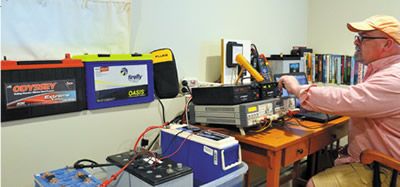Twice now on two different bikes (a '75 Goldwing and a '99 Triumph Trophy 900) I've had the regulator go wonky. In both cases the regulator started charging over 15.5V, up to 16V. Partly because of that I somewhat regularly check to see if things are normal (after the bike has been sitting to check for parasitic losses/age, after a ride, when idling, and with some RPM). I would say at least 3-4 times a season.
For what it's worth, I replaced the regulator on the Trophy with an RMStator branded regulator which uses an integrated circuit which is much faster and more accurate. I was very happy with the results (a very tightly controlled charge voltage from idle through high RPM). I have not yet diagnosed the GL1000 because I have too much to do and I only noticed a month or so ago.
On my ST1300 I have a USB charger/Volt Meter that I religiously pay attention to. They are cheap and the voltage fluctuates a great deal on the display (13.2 13.6 13.1 13.9 every 0.2 seconds or whatever) but it tells me roughly where things are.
Generally speaking, all of my bikes are
always plugged into a long-term safe maintainer. I prefer BatteryMinder (built like a flippin' tank) but I also have two different MotoBatt-branded chargers (these are... not robustly built. I can't recommend them.) See below for more details.
@St-Gerard said:
One note on chargers ,Agm batteries don't like the disulfating mod.
I think I'd like you to back that up with some evidence. While I'm not sure that desulfating makes a difference one way or the other, almost all modern battery chargers desulfate and battery manufacturers that I've spoken to (such as MotoBatt)
recommend a desulfating charger. My old BatteryMinder model 2012 (which isn't even made "special" for AGM batteries) desulfates and using that I regularly see my batteries last 2-3 times as long as my friends' batteries. Hardly compelling evidence, I know, but flat-out stating that AGM batteries don't like desulfating chargers is a bold claim that I think warrants some sort of evidence.
For what it's worth, I have (3) chargers/maintainers that I use on a regular basis. Two are MotoBatt branded and one is BatteryMinder branded.
Observe the variation in resting/float voltages used by each of the 3 chargers (and two of the chargers support different modes). I personally prefer higher voltages for AGM. I have no standard batteries except those in autos, and even then I have no problem with 14.4V.
| Charger | Mode | Voltage |
| Battery Minder 2012 (non-AGM version) | n/a | 13.4 |
| MotoBatt MBRC1 (1.5A, wall-wart) | 12v Standard | 14.2 |
| MotoBatt MBRC1 (1.5A, wall-wart) | 12v AGM/Winter | 14.4 |
| MotoBatt MBRC35 (3.5A) | 12v Standard | 13.2 |
| MotoBatt MBRC35 (3.5A) | 12v AGM/Winter | 13.6 |

 www.practical-sailor.com
www.practical-sailor.com
